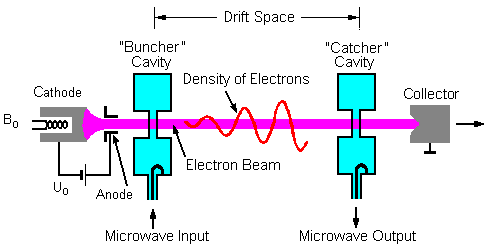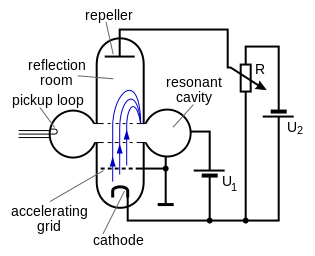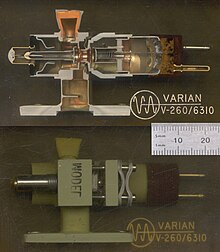Klystron: Difference between revisions
m Dating maintenance tags: {{Refimprove}} |
added reference |
||
| Line 2: | Line 2: | ||
{{Refimprove|date=January 2013}} |
{{Refimprove|date=January 2013}} |
||
[[Image:Klystron.jpg|250px|thumb|right|High-power klystron used at the [[Canberra Deep Space Communications Complex]]. (Klystrons used for generating heterodyne reference frequencies in radar receivers are about the size of a [[Whiteboard|whiteboard pen]].)]] |
[[Image:Klystron.jpg|250px|thumb|right|High-power klystron used at the [[Canberra Deep Space Communications Complex]]. (Klystrons used for generating heterodyne reference frequencies in radar receivers are about the size of a [[Whiteboard|whiteboard pen]].)]] |
||
A '''klystron''' is a specialized [[linear particle accelerator|linear-beam]] [[vacuum tube]] (evacuated electron tube). Klystrons are used as amplifiers at [[microwave]] and [[radio]] frequencies to produce both low-power reference signals for [[superheterodyne]] [[radar]] receivers and to produce high-power carrier waves for applications such as [[radar]] and [[microwave relay]] transmitters, and the driving force for modern [[particle accelerator]]s. |
A '''klystron''' is a specialized [[linear particle accelerator|linear-beam]] [[vacuum tube]] (evacuated electron tube).<ref>http://books.google.com.ni/books/about/Klystron.html?id=I87zQwAACAAJ&redir_esc=y</ref> Klystrons are used as amplifiers at [[microwave]] and [[radio]] frequencies to produce both low-power reference signals for [[superheterodyne]] [[radar]] receivers and to produce high-power carrier waves for applications such as [[radar]] and [[microwave relay]] transmitters, and the driving force for modern [[particle accelerator]]s. |
||
Klystron amplifiers have the advantage (over the [[magnetron]]) of coherently amplifying a reference signal so its output may be precisely controlled in [[amplitude]], [[frequency]] and [[phase (waves)|phase]]. Many klystrons use [[waveguide]]s for coupling microwave energy into and out of the device, although it is also quite common for lower power and lower frequency klystrons to use [[coaxial cable]] couplings instead. In some cases a coupling probe is used to couple the microwave energy from a klystron into a separate external waveguide. |
Klystron amplifiers have the advantage (over the [[magnetron]]) of coherently amplifying a reference signal so its output may be precisely controlled in [[amplitude]], [[frequency]] and [[phase (waves)|phase]]. Many klystrons use [[waveguide]]s for coupling microwave energy into and out of the device, although it is also quite common for lower power and lower frequency klystrons to use [[coaxial cable]] couplings instead. In some cases a coupling probe is used to couple the microwave energy from a klystron into a separate external waveguide. |
||
Revision as of 00:53, 7 February 2013
This article needs additional citations for verification. (January 2013) |

A klystron is a specialized linear-beam vacuum tube (evacuated electron tube).[1] Klystrons are used as amplifiers at microwave and radio frequencies to produce both low-power reference signals for superheterodyne radar receivers and to produce high-power carrier waves for applications such as radar and microwave relay transmitters, and the driving force for modern particle accelerators.
Klystron amplifiers have the advantage (over the magnetron) of coherently amplifying a reference signal so its output may be precisely controlled in amplitude, frequency and phase. Many klystrons use waveguides for coupling microwave energy into and out of the device, although it is also quite common for lower power and lower frequency klystrons to use coaxial cable couplings instead. In some cases a coupling probe is used to couple the microwave energy from a klystron into a separate external waveguide.
All modern klystrons are amplifiers, since reflex klystrons, which were used as oscillators in the past, have been surpassed by alternative technologies.
The name klystron comes from the stem form κλυσ- (klys) of a Greek verb referring to the action of waves breaking against a shore, and the end of the word electron.
History
The brothers Russell and Sigurd Varian of Stanford University are the inventors of the klystron. Their prototype was completed in August 1937. Upon publication in 1939,[2] news of the klystron immediately influenced the work of US and UK researchers working on radar equipment. The Varians went on to found Varian Associates to commercialize the technology (for example to make small linear accelerators to generate photons for external beam radiation therapy). Their work built on the description of velocity modulation by A. Arsenjewa-Heil and Oskar Heil (wife and husband) in 1935, though the Varians were probably unaware of the Heil's work.[3]
The work of physicist W.W. Hansen was instrumental in the development of the klystron and was cited by the Varian brothers in their 1939 paper. His resonator analysis, which dealt with the problem of accelerating electrons toward a target, could be used just as well to decelerate electrons (i.e., transfer their kinetic energy to RF energy in a resonator). During the second World War, Hansen lectured at the MIT Radiation labs two days a week, commuting to Boston from Sperry gyroscope company on Long Island. His resonator was called a "rhumbatron" by the Varian brothers. Hansen died of beryllium disease in 1949 as a result of exposure to beryllium oxide (BeO).
During the Second World War, the Axis powers relied mostly on (then low-powered and long wavelength) klystron technology for their radar system microwave generation, while the Allies used the far more powerful but frequency-drifting technology of the Cavity magnetron for much shorter one centimeter microwave generation. Klystron tube technologies for very high-power applications, such as synchrotrons and radar systems, have since been developed.
Right after WW II AT&T used 4 watt klystrons in its brand new network of microwave links that covered the US continent. The network provided long distance telephone service and also carried television signals for the major TV networks. Western Union Telegraph Company also built point-to-point microwave communication links using intermediate repeater stations at about 40 mile intervals at that time, using 2K25 reflex klystrons in both the transmitters and receivers.
Explanation
Klystrons amplify RF signals by converting the kinetic energy in a DC electron beam into radio frequency power. A beam of electrons is produced by a thermionic cathode (a heated pellet of low work function material), and accelerated by high-voltage electrodes (typically in the tens of kilovolts). This beam is then passed through an input cavity. RF energy is fed into the input cavity at, or near, its natural frequency to produce a voltage which acts on the electron beam. The electric field causes the electrons to bunch: electrons that pass through during an opposing electric field are accelerated and later electrons are slowed, causing the previously continuous electron beam to form bunches at the input frequency. To reinforce the bunching, a klystron may contain additional "buncher" cavities. The RF current carried by the beam will produce an RF magnetic field, and this will in turn excite a voltage across the gap of subsequent resonant cavities. In the output cavity, the developed RF energy is coupled out. The spent electron beam, with reduced energy, is captured in a collector.
Two-cavity klystron amplifier

In the two-chamber klystron, the electron beam is injected into a resonant cavity. The electron beam, accelerated by a positive potential, is constrained to travel through a cylindrical drift tube in a straight path by an axial magnetic field. While passing through the first cavity, the electron beam is velocity modulated by the weak RF signal. In the moving frame of the electron beam, the velocity modulation is equivalent to a plasma oscillation. Plasma oscillations are rapid oscillations of the electron density in conducting media such as plasmas or metals.(The frequency only depends weakly on the wavelength). So in a quarter of one period of the plasma frequency, the velocity modulation is converted to density modulation, i.e. bunches of electrons. As the bunched electrons enter the second chamber they induce standing waves at the same frequency as the input signal. The signal induced in the second chamber is much stronger than that in the first. When the tube is energized, the cathode emits electrons which are focused into a beam by a low positive voltage on the control grid. The beam is then accelerated by a very high positive dc potential that is applied in equal amplitude to both the accelerator grid and the buncher grids. The buncher grids are connected to a cavity resonator that superimposes an ac potential on the dc voltage. Ac potentials are produced by oscillations within the cavity that begin spontaneously when the tube is energized. The initial oscillations are caused by random fields and circuit imbalances that are present when the circuit is energized. The oscillations within the cavity produce an oscillating electrostatic field between the buncher grids that is at the same frequency as the natural frequency of the cavity. The direction of the field changes with the frequency of the cavity. These changes alternately accelerate and decelerate the electrons of the beam passing through the grids. The area beyond the buncher grids is called the DRIFT SPACE. The electrons form bunches in this area when the accelerated electrons overtake the decelerated electrons.
The function of the CATCHER GRIDS is to absorb energy from the electron beam. The catcher grids are placed along the beam at a point where the bunches are fully formed. The location is determined by the transit time of the bunches at the natural resonant frequency of the cavities (the resonant frequency of the catcher cavity is the same as the buncher cavity). The location is chosen because maximum energy transfer to the output (catcher) cavity occurs when the electrostatic field is of the correct polarity to slow down the electron bunches. The feedback path provides energy of the proper delay and phase relationship to sustain oscillations. A signal applied at the buncher grids will be amplified if the feedback path is removed.
Two-cavity klystron oscillator
The two-cavity amplifier klystron is readily turned into an oscillator klystron by providing a feedback loop between the input and output cavities. Two-cavity oscillator klystrons have the advantage of being among the lowest-noise microwave sources available, and for that reason have often been used in the illuminator systems of missile targeting radars. The two-cavity oscillator klystron normally generates more power than the reflex klystron—typically watts of output rather than milliwatts. Since there is no reflector, only one high-voltage supply is necessary to cause the tube to oscillate, the voltage must be adjusted to a particular value. This is because the electron beam must produce the bunched electrons in the second cavity in order to generate output power. Voltage must be adjusted to vary the velocity of the electron beam (and thus the frequency) to a suitable level due to the fixed physical separation between the two cavities. Often several "modes" of oscillation can be observed in a given klystron.
Reflex klystron


In the reflex klystron (also known as a 'Sutton' klystron after its inventor, Robert Sutton), the electron beam passes through a single resonant cavity. The electrons are fired into one end of the tube by an electron gun. After passing through the resonant cavity they are reflected by a negatively charged reflector electrode for another pass through the cavity, where they are then collected. The electron beam is velocity modulated when it first passes through the cavity. The formation of electron bunches takes place in the drift space between the reflector and the cavity. The voltage on the reflector must be adjusted so that the bunching is at a maximum as the electron beam re-enters the resonant cavity, thus ensuring a maximum of energy is transferred from the electron beam to the RF oscillations in the cavity. The voltage should always be switched on before providing the input to the reflex klystron as the whole function of the reflex klystron would be destroyed if the supply is provided after the input. The reflector voltage may be varied slightly from the optimum value, which results in some loss of output power, but also in a variation in frequency. This effect is used to good advantage for automatic frequency control in receivers, and in frequency modulation for transmitters. The level of modulation applied for transmission is small enough that the power output essentially remains constant. At regions far from the optimum voltage, no oscillations are obtained at all. This tube is called a reflex klystron because it repels the input supply or performs the opposite function of a klystron.
There are often several regions of reflector voltage where the reflex klystron will oscillate; these are referred to as modes. The electronic tuning range of the reflex klystron is usually referred to as the variation in frequency between half power points—the points in the oscillating mode where the power output is half the maximum output in the mode. The frequency of oscillation is dependent on the reflector voltage, and varying this provides a crude method of frequency modulating the oscillation frequency, albeit with accompanying amplitude modulation as well.
Modern semiconductor technology has effectively replaced the reflex klystron in most applications.
Multicavity klystron

In all modern klystrons, the number of cavities exceeds two. A larger number of cavities may be used to increase the gain of the klystron, or to increase the bandwidth.
Tuning a klystron
Some klystrons have cavities that are tunable. Tuning a klystron is delicate work which, if not done properly, can cause damage to equipment or injury to the technician. By adjusting the frequency of individual cavities, the technician can change the operating frequency, gain, output power, or bandwidth of the amplifier. The technician must be careful not to exceed the limits of the graduations, or damage to the klystron can result.
Manufacturers generally send a card with the unique calibrations for a klystron's performance characteristics, that lists the graduations to be set to attain any of a set of listed frequencies. No two klystrons are exactly identical (even when comparing like part/model number klystrons), and so every card is specific to the individual unit. Klystrons have serial numbers on each of them to uniquely identify each unit, and for which manufacturers may (hopefully) have the performance characteristics in a database. If not, loss of the calibration card may be an economically insoluble problem, making the klystron unusable or perform marginally un-tuned.
Other precautions taken when tuning a klystron include using nonferrous tools. Some klystrons employ permanent magnets. If a technician uses ferrous tools, (which are ferromagnetic), and comes too close to the intense magnetic fields that contain the electron beam, such a tool can be pulled into the unit by the intense magnetic force, smashing fingers, injuring the technician, or damaging the unit. Special lightweight nonmagnetic (aka diamagnetic) tools made of beryllium alloy have been used for tuning U.S. Air Force klystrons.
Precautions are routinely taken when transporting klystron devices in aircraft, as the intense magnetic field can interfere with magnetic navigation equipment. Special overpacks are designed to help limit this field "in the field," and thus allow such devices to be transported safely.
Optical klystron
In an optical klystron the cavities are replaced with undulators. Very high voltages are needed. The electron gun, the drift tube and the collector are still used.
Floating drift tube klystron
The floating drift tube klystron has a single cylindrical chamber containing an electrically isolated central tube. Electrically, this is similar to the two cavity oscillator klystron with a lot of feedback between the two cavities. Electrons exiting the source cavity are velocity modulated by the electric field as they travel through the drift tube and emerge at the destination chamber in bunches, delivering power to the oscillation in the cavity. This type of oscillator klystron has an advantage over the two-cavity klystron on which it is based. It only needs one tuning element to effect changes in frequency. The drift tube is electrically insulated from the cavity walls, and DC bias is applied separately. The DC bias on the drift tube may be adjusted to alter the transit time through it, thus allowing some electronic tuning of the oscillating frequency. The amount of tuning in this manner is not large and is normally used for frequency modulation when transmitting.
Collector
After the RF energy has been extracted from the electron beam, the beam is destroyed in a collector. Some klystrons include depressed collectors, which recover energy from the beam before collecting the electrons, increasing efficiency. Multistage depressed collectors enhance the energy recovery by "sorting" the electrons in energy bins.
Applications
Klystrons can produce far higher microwave power outputs than solid state microwave devices such as Gunn diodes. In modern systems, they are used from UHF (hundreds of MHz) up through hundreds of gigahertz (as in the Extended Interaction Klystrons in the CloudSat satellite). Klystrons can be found at work in radar, satellite and wideband high-power communication (very common in television broadcasting and EHF satellite terminals), medicine (radiation oncology), and high-energy physics (particle accelerators and experimental reactors). At SLAC, for example, klystrons are routinely employed which have outputs in the range of 50 megawatts (pulse) and 50 kilowatts (time-averaged) at frequencies nearing 3 GHz.
Popular Science's "Best of What's New 2007"[5][6] described a company, Global Resource Corporation, currently defunct, using a klystron to convert the hydrocarbons in everyday materials, automotive waste, coal, oil shale, and oil sands into natural gas and diesel fuel.[7]
See also
References
- ^ http://books.google.com.ni/books/about/Klystron.html?id=I87zQwAACAAJ&redir_esc=y
- ^ Varian, R. H.; Varian, S. F. (1939). "A High Frequency Oscillator and Amplifier". Journal of Applied Physics. 10 (5): 321. Bibcode:1939JAP....10..321V. doi:10.1063/1.1707311.
- ^ George Caryotakis (November 18, 1997). "Invited paper: The Klystron: A microwave source of surprising range and endurance" (PDF). American Physics Society: Division of Plasma Physics Conference, Pittsburg, PA. Stanford, CA: Stanford SLAC.
- ^ http://www.radiomuseum.org/tubes/tube_v-260.html
- ^ "PopSci's Best of What's New 2007". Popsci.com. Retrieved 2010-02-28.
- ^ "PopSci's Best of What's New 2007". Popsci.com. Retrieved 2010-02-28.
- ^ US Patent 7629497 - Microwave-based recovery of hydrocarbons and fossil fuels Issued on December 8, 2009
External links
- Animation of how a Klystron works
- (Two cavity klystron)
- (Multicavity klystron)
- (Reflex klystron)
- (High power for linear accelerator)
- History of the Klystron from Varian
- Stanford Linear Accelerator Center (249) Klyston Gallery Pictures
- Klystron collection in the Virtual Valve Museum
- Klystron Amplifier
- "Microwave Gun" klystron developed at the SLAC
